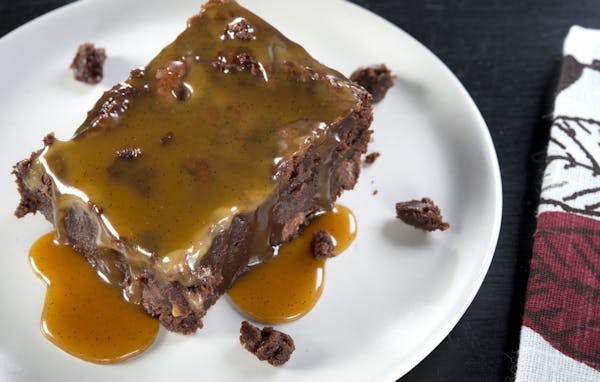Salted caramel is a classic flavor mashup that the French mastered centuries ago, but its stateside popularity has bubbled over in recent years. Go to the grocery store and you'll find salted caramel-flavored brownie mixes, ice cream, peanut butter — even vodka. Cold Stone Creamery serves a Salted Caramel Frappé, and Starbucks has its Salted Caramel Mocha.
Salted caramel could be on track to replace pumpkin spice as the "it" fall flavor. According to data gathered by the health-tracker app MyFitnessPal, pumpkin spice consumption dropped 7.3 percent from 2014 to 2015, while demand for salted caramel products rose by 7 percent.
But unlike pumpkin spice, the salty-sweet flavor is enjoyed year-round. And it might have more staying power.
Salt and caramel "is one of those classic combinations that will never go out of style," says Christopher Elbow of Elbow Artisan Chocolates and Glacé Artisan Ice Cream in Kansas City, MO.
Caramel is delicious on its own, Elbow says, but something magical happens whsen you introduce salt.
"Every time I make caramel, I put a little bit of salt in it," he says. "It really makes that caramel flavor pop."
The type of salt matters. He likes the subtle mineral flavors of sel gris, but other salted caramel recipes call for English Maldon sea salt, which is less bitter than table salt and has pyramid-shaped crystals.
Jonathan and Amy Pitcher of Bizz & Weezy Confections sprinkle their popular dark chocolate caramels with Murray River sea salt from Australia. The pink flakes have a touch of earthy minerality that complements the chocolate, Jonathan says.
But making caramel from scratch? That can be tricky.
When the Pitchers started making caramel four years ago, they ruined nearly $15,000 of product. Most of the bad batches were burnt.
"Caramel can be temperamental if you don't follow some key rules," Elbow says.
The tricky part is heating the sugar just until it develops its deep caramel flavor — and pulling it from the heat before it turns bitter, crystallizes or burns. Elbow recommends swirling the pan as the caramel cooks.
"You never want to stir it, because that promotes crystallization," Elbow says.
But be careful when swirling, because molten sugar is extremely hot.
Tim Veith of Ibis Bakery in Lenexa, Kan., perfected his caramel skills working at Elbow Artisan Chocolates for three years and is also a fan of the swirl method. He recommends cooking sugar with water (the "wet method" as opposed to the "dry method") and a lid that traps steam and washes sugar granules down the sides of the pot before they can form crystals.
"Those one or two crystals can cause the whole batch to turn to a solid mass," Veith says.
Jonathan Pitcher, who is now a caramel pro, is all about the low and slow method. He cooks caramel at 275 degrees on an induction range. It takes longer, he says, but the caramel is harder to burn at that heat.
Many batches get ruined when the sugar is scorched by the bottom or sides of the pan. If that happens, Pitcher says it's important to not scrape the sides of the pan.
If you think you've ruined it, add more cream or butter, he says. You might find that it tastes just fine — and even better with a healthy pinch of salt.

Kao Kalia Yang, Edel Rodriguez and others bring us gorgeous new picture books

After 4 decades in music and major vocal surgery, Jon Bon Jovi is optimistic and still rocking

Lt. Gov. Peggy Flanagan hits the runway at Native Nations Fashion Night

